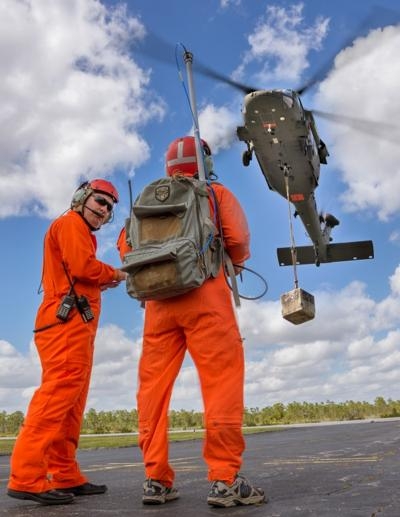Wed, Apr 23, 2014
Showed Autonomous Hover And Flight Operations For U.S. Army
In cooperation with the U.S. Army, Sikorsky has successfully demonstrated optionally piloted flight of a Black Hawk helicopter, a significant step toward providing autonomous cargo delivery functionality to the U.S. Army.

The Optionally Piloted Black Hawk (OPBH) Demonstrator, known as Sikorsky’s Manned/Unmanned Resupply Aerial Lifter (MURAL) Program, conducted the successful first flight demonstration on March 11 at Sikorsky’s Development Flight Center. The demonstration was conducted through the use of Sikorsky’s Matrix Technologies and advanced Ground Control Station (GCS) Technologies.
The OPBH demonstrated autonomous hover and flight operations while under the control of a man-portable GCS, demonstrating the capability for expeditionary operations and critical cargo resupply. “The autonomous Black Hawk helicopter provides the commander with the flexibility to determine crewed or un-crewed operations, increasing sorties while maintaining crew rest requirements. This allows the crew to focus on the more ‘sensitive’ operations, and leaves the critical resupply missions for autonomous operations without increasing fleet size or mix,” said Mark Miller, Sikorsky Vice President of Research & Engineering.
The MURAL Program is a cooperative effort between the U.S. Army Aviation Development Directorate (ADD), the U.S. Army Utility Helicopters Project Office (UH PO) and Sikorsky. The UH PO is providing access to two UH-60MU Black Hawk helicopters and Sikorsky is applying the technology it has developed with Internal Research and Development funding.
Sikorsky has been developing the technology since 2007, and signed a Cooperative Research & Development Agreement (CRADA) with the U.S. Army in 2013 to advance the program to a formal effort to demonstrate the full flexibility and value of a full authority flight control system. The effort includes demonstration of expeditionary ground control systems and precision control. “The ADD’s mission is to focus on developing, demonstrating and applying critical technologies that enhance the capability, affordability, readiness and safety of Department of Defense aviation systems,” said Dr. William Lewis, Director, ADD. “The optionally piloted Black Hawk helicopter functionality stands to bring added value to DoD aviation systems, through the innovations being tested on the Black Hawk helicopter in the MURAL program.”
According to COL Thomas Todd, the Utility Helicopters Project Manager, “MURAL technology will advance material solutions related to Degraded Visual Environment operations. These solutions will provide critical flight control and flight handling quality improvements.”
Sikorsky introduced its Matrix Technology, a major research program, in July 2013 to develop, test and field systems and software that will improve significantly the capability, reliability and safety of flight for autonomous, optionally piloted, and piloted vertical take-off and landing (VTOL) aircraft. The Sikorsky Autonomy Research Aircraft (SARA) flew its first flight on July 26, 2013 and continues to explore new functionality in that portion of the program.
The application of Matrix Technology to the OPBH is an initial step toward demonstrating the flexibility, adaptability and capability to a range of aircraft systems. “Applying Matrix Technology to an already robust, reliable, and safe platform leverages these capabilities while expanding the system’s effectiveness,” Miller added.
Matrix aims to give rotary and fixed wing VTOL aircraft a high level of system intelligence needed to complete complex missions with minimal human oversight and at low altitudes where obstacles abound.
(Image provided by Sikorsky)
More News
Also: SkyReach Parts Support, Piper Service Ctr, Airliner Near-Miss, Airshow London The Judge overseeing Icon's convoluted Chapter 11 process has approved $9 million in Chapter 11 >[...]
ILS PRM Approach An instrument landing system (ILS) approach conducted to parallel runways whose extended centerlines are separated by less than 4,300 feet and at least 3,000 feet >[...]
Aero Linx: FlyPups FlyPups transports dogs from desperate situations to fosters, no-kill shelters, and fur-ever homes. We deliver trained dogs to veterans for service and companion>[...]
Also: Skydio Chief, Uncle Sam Sues, Dash 7 magniX, OR UAS Accelerator US Secretary of the Air Force Frank Kendall was given a turn around the patch in the 'X-62A Variable In-flight>[...]
Also: NBAA on FAA Reauth, DJI AG Drones, HI Insurance Bill Defeated, SPSA Airtankers The Beechcraft Denali continues moving forward towards certification, having received its FAA T>[...]
 Airborne 05.10.24: Icon Auction, Drunk MedEvac Pilot, Bell ALFA
Airborne 05.10.24: Icon Auction, Drunk MedEvac Pilot, Bell ALFA ANN's Daily Aero-Term (05.13.24): ILS PRM Approach
ANN's Daily Aero-Term (05.13.24): ILS PRM Approach ANN's Daily Aero-Linx (05.13.24)
ANN's Daily Aero-Linx (05.13.24) Airborne-NextGen 05.07.24: AI-Piloted F-16, AgEagle, 1st 2 WorldView Sats
Airborne-NextGen 05.07.24: AI-Piloted F-16, AgEagle, 1st 2 WorldView Sats Airborne 05.08.24: Denali Update, Dad-Daughter Gyro, Lake SAIB
Airborne 05.08.24: Denali Update, Dad-Daughter Gyro, Lake SAIB



